N e w s B r i e f s
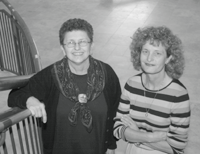
Judith
Lupo Wold (left), 81MN, and
Lorine Spencer lead the Migrant Family
Health Program, which moved from
Georgia State to Emory this year.
Fields
of Compassion
Migrant
health project moves to Emory
This summer, an intrepid
group of nursing students will head to southwest Georgia for what could
be the most memorable nursing experience of their lives. They are the
first Emory students to take part in the Migrant Family Health Program,
which has come to roost in the School of Nursing.
Previously based at Georgia State University (GSU), the annual program
provides health screening, health education, and episodic care for some
1,000 farm workers and their children. Dr. Judith Lupo Wold, 81MN, a visiting
scholar at Emory who teaches on the GSU nursing faculty, was instrumental
in orchestrating the program’s transition.
According to Lorine Spencer, the nursing consultant who started the program
at GSU and now holds the reins at Emory, students can expect “an
intensive immersion learning experience.”
For two consecutive weeks, about 30 baccalaureate and nurse practitioner
students will work in an elementary school each morning to assess and
examine 500 children enrolled in a summer education program. In the evening,
the nursing students will staff a mobile clinic to assess, examine, and
treat adults at work camps and packing houses in three counties. Most
afternoons, students will attend seminars to discuss topics related to
migrant health.
“This program helps students tremendously by exposing them to all
types of health problems, people, and cultures,” says Spencer, who
has had no trouble convincing Emory nursing faculty to go along. “We
see a lot of Hispanic people as well as Haitians and people from other
Caribbean Islands. It also exposes students to rural life. Some of them
have never seen where fruits and vegetables come from, how they are grown,
and what it takes to get those crops from the field to the grocery store
to the table.”
Joining the group will be students from the dental hygiene department
at Clayton State College and University and the physical therapy and psychology
departments at GSU. Many other partners are involved, including the Southeastern
Primary Care Consortium/Atlanta Area Health Education Center, South Georgia
College (which supplies the Nightingale van that serves as the mobile
clinic), the Georgia Department of Human Resources, the Colquitt County
Health Department, and local farm owners, physicians, churches, businesses,
and volunteers. In addition, volunteers from metro Atlanta accompany students
and faculty to provide interpretive services and support. These volunteers
also assist farm workers and their families in the fields and packing
sheds where they work and the camps where they live.
The Migrant Family Health Program is based in Moultrie, Georgia, where
students and faculty spend the night to regroup and recharge for the next
day. Throughout the two weeks, they give out hundreds of goody bags filled
with donated items to children and adults. Many students and faculty bring
used clothing and household items to share with families.
On a hot day one previous summer, Spencer felt an eager tug on the leg
of her pants. She looked down to see a 4-year-old Guatemalan boy wearing
the pants and shirt she had helped him pick out the day before.
Any exhaustion she felt at the time quickly faded. As Spencer explains,
“This is why I continue to do this work.”
A
Voice
for
Nursing
Salmon joins
health care
philanthropy
board
The
Robert Wood Johnson Foundation has a stronger ear and voice on behalf
of nursing, since Dean Marla Salmon was elected to the organization’s
board of trustees.
Salmon brings her own brand of leadership to the board as an expert in
national and international public health and health policy and administration.
“Her research interests on the critical problem of the health care
workforce will bring excellent background to the table as we think about
the nation’s coming health and health care challenges,” notes
foundation president and CEO Steven Schroeder.
Based in Princeton, New Jersey, the foundation is the nation’s largest
philanthropy devoted to health and health care. The foundation works to
assure that all Americans have access to health care at reasonable cost,
improve care and support for people with chronic health conditions, promote
healthy communities and lifestyles, and reduce the personal, social, and
economic harm caused by tobacco, alcohol, and drug abuse.
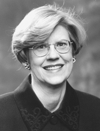
Anne R. Bavier, 73MN
Nurse
of Distinction
Bavier
receives top staff honor from Emory
Emory honored Anne
R. Bavier, 73MN, this spring as one of 12 individuals to receive a 2002
Award of Distinction, the university’s highest honor for staff members.
Bavier joined the School of Nursing in 1997 and juggles lots of balls
as assistant dean for development, alumni, and external relations.
Last year, Bavier spearheaded the dedication ceremony for the school’s
new building and provided lead support to get the Lillian Carter Center
for International Nursing up and running. She also oversees preparations
for Alumni Weekend and other special events.
Dean Marla Salmon said it best in her letter nominating Bavier for the
award. She wrote, “Anne has served with great distinction in a position
that is uniquely complex, played multiple roles, and consistently kept
the best interest of the university, the Woodruff Health Sciences Center,
and the School of Nursing in the forefront of her concerns.”
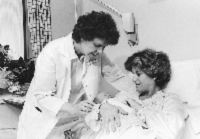
Jean Stone Megenity
Teacher,
Mentor, Leader, Friend
Professor
Emerita Jean Megenity dies
Professor Emerita Jean Stone Megenity (left in photo) cared deeply
about mothers and babies. And many others, too. Megenity, who taught at
the School of Nursing for 20 years, passed away on March 16 at her home
in Duluth, Georgia, from metastatic breast cancer.
Reared on a farm in Indiana, Megenity began her nursing career in 1949.
Although primarily interested in maternity nursing, she worked in public
health, school nursing, outpatient clinics, occupational health, and hospitals.
She began her teaching career in 1968 at Prairie State College in Illinois
and taught one year at the University of Florida before joining the School
of Nursing in 1971.
From day one at Emory, Megenity touched the lives of many through teaching,
scholarship, service, and leadership. “Students and faculty who were
mentored by Jean loved her for her kindness and care while she challenged
them to do their best,” remembers Rose Cannon, clinical associate
professor of nursing. “She served as a role model, always demonstrating
the difference a skilled practitioner could make in the delivery of health
care.”
Megenity excelled in curriculum planning and implemented a new RN track
in 1981. She designed an innovative undergraduate clinical experience
where students provided support and teaching to childbearing families,
before and after delivery. Attendance at the birth was mandatory—anytime,
day or night. Megenity also organized an annual conference on breast-feeding,
and the 14th gathering was held earlier this year. “Jean’s desire
to promote and protect the health of mothers and babies was a vital motivating
factor in developing the conference,”says Cannon.
Faculty also held Megenity in high regard for her efforts to create a
research culture in the School of Nursing and across Georgia. She chaired
the Alpha Epsilon Chapter Research Committee, resulting in the collegial
study of touch in nursing practice. As a result, Megenity received a research
award from the Alpha Epsilon Chapter of Sigma Theta Tau International
and was nominated by the Georgia Nurses Association (GNA) for the American
Nurses Association (ANA) Research Award.
Megenity also liked to shake things up politically. She served as president
of the Emory University Senate from 1982 to 1983 and was not shy about
introducing young nurses to the advantages of GNA and ANA membership and
the benefits of serving the profession, whether on a legislative phone
tree, marching to the state capitol, or serving on committees.
She shared her passion for teaching with her husband, Jack, also an educator,
and they produced a textbook together. Published in 1982, Patient Teaching:
Theories, Techniques, and Strategies was widely used in nursing schools.
They also raised two children and in recent years took great delight in
their four grandsons.
Memorial gifts may be sent to the
Jean Stone Megenity Research Fund,
payable to the Alpha Epsilon Chapter of
Sigma Theta Tau International,
c/o the Nell Hodgson Woodruff School of Nursing,
1520 Clifton Road NE, Atlanta, Georgia 30322.
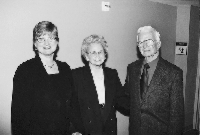
Before giving this year’s Jowers lecture, Audrey Nelson met Edna and Marvin Jowers, who established the lectureship as a tribute to their son, David, who cared deeply about people and the environment.
Innovations
in Patient Safety
VA nurse researcher presents Jowers lecture
Audrey Nelson, 80MN,
is a self-confessed closet engineer. That suits her well as associate
chief for nursing service research at the James A. Haley Veteran’s
Hospital in Tampa, Florida, where she directs the Center for Patient Safety
Inquiry. Nearly 5 years old, the center seeks to prevent falls among elderly
and disabled patients and make the work environment safer for nurses and
other experts who care for them.
Already, the center expects to reduce the incidence of falls by 50% in
all Veterans Administration (VA) hospitals in Florida and by 30% in 45
VA hospitals nationwide. In addition, the center is looking to reduce
the severity of staff injuries by 60% in 24 VA hospitals nationally. Nelson
believes that success is even greater since 40 VA hospitals have adopted
the center’s new ergonomics guide, which helps caregivers move patients
more easily and safely and reduce the number of work injuries.
“That means nurses will stay in the field longer and more experienced
nurses will be taking care of patients instead of brand new nurses,”
Nelson told guests during the David Jowers Lectureship. Established by
Edna and Marvin Jowers, the annual lectureship is a tribute to their late
son, who cared deeply about the environment and the welfare of people.
This year, the School of Nursing and Wesley Woods Center, Emory’s
geriatric health care facility, presented the lecture together. In doing
so, they illustrated that caring for elderly and frail patients calls
for interdisciplinary and interprofessional collaboration.
These partnerships drive the Center for Patient Safety Inquiry. During
the past decade, Nelson and her colleagues have received more than $20
million in research funding to improve patient safety by looking at ways
to prevent medical errors and adverse outcomes.
In doing so, the Center for Patient Safety Inquiry provides patients with
more personal freedom and creates a “culture of safety” for
clinicians working in VA hospitals in Florida and Puerto Rico. Nelson
oversees this work in four research laboratories housed in a new nursing
research building at the VA hospital in Tampa.
The labs are definitely state of the art. In the patient safety simulation
lab, researchers use mannequins fitted with dignity monitors to measure
different variables. By controlling the work environment, the task, and
the equipment, researchers can clearly observe how a nurse gives care
in order to increase the layers of defense for patients.
The Center for Patient Safety Inquiry is making inroads in other ways.
Its biomechanics research laboratory has one of only two three-dimensional
body-tracking systems in the country. This system captures data on how
nurses move to perform their jobs. Researchers use a new gait and balance
lab to study how certain movements cause falls and what can be done to
prevent them. A fourth lab devoted to patient safety engineering tests
new devices and technologies to help nurses perform their jobs efficiently
and safety.
This lab is where Nelson puts on her engineering hat. She likes to quote
TV sitcom star Roseanne, who once joked that “if more engineers had
to do housework, we’d have riding vacuum cleaners by now.”
“I think the same is true for health care,” Nelson said. “If
we use the talent of engineers and pull them in, so many of the patient
defenses that I’m talking about could be buffered. Technology holds
a lot of promise.”
To learn more about the Center for Patient Safety
Inquiry, visit the website at www.patientsafetycenter.com.
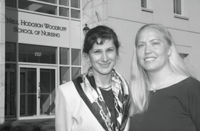
Associate Professor Elizabeth Capezuti (left) knew from the start that Laura Wagner was destined to become a nurse scholar in geriatrics. Wagner is a PhD student who came to Emory to study with Capezuti.
One
Good Turn Leads to Another
PhD student receives prestigious geriatrics grant
Emory doctoral student
Laura Wagner is one of 20 nurse scholars nationwide to receive a $100,000
grant from the John A. Hartford Foundation. Her funding is part of a program
to produce academicians, practitioners, researchers, and leaders in geriatric
nursing. In turn, these individuals help cultivate the next generation
of geriatrics practitioners and faculty.
Wagner began working on her PhD last fall on the advice of Associate Professor
Elizabeth Capezuti, holder of the Independence Foundation– Wesley
Woods Chair in Gerontologic Nursing. The two met at the University of
Pennsylvania School of Nursing, where Wagner received her master’s
degree and Capezuti was a faculty member and geriatrics nursing researcher.
Capezuti knew right away that Wagner was destined to become a nurse scholar.
“She had a strong interest in research, and she began working on
several of my nursing home research projects,” says Capezuti. “Within
a short time, she began coordinating some projects and was an excellent
supervisor for the other student research assistants.”
Recognizing Wagner’s strengths, Capezuti suggested that she gain
experience as a geriatric nurse practitioner in a nursing home to become
familiar with what areas needed study. Wagner worked for two years at
a nursing home in Columbus, Ohio, where she learned how nursing homes
operate and how care can be improved. Through her doctoral studies at
Emory, she is focusing on attracting younger nurses to geriatric nursing,
improving the nursing care of residents in nursing homes, and researching
innovative ways to reduce falls and fall-related injuries.
“Research in geriatric nursing is the vehicle for how practice and
policy is changed in nursing homes,” explains Wagner, who came to
Emory specifically to study with Capezuti. “I want to help change
how care is delivered and the way that is done by changing current policy
based on good research.”
Change
of Heart
Nursing
applications
jump
dramatically
It
appears that some prospective students have had a change of heart in planning
their careers. This spring, the School of Nursing experienced a remarkable
47% increase in undergraduate applications. Additionally, the school received
69% more inquiries from prospective students and a 52.8% increase in deposits
compared with last year.
“I think September 11 is a very important factor,” says Dean
Marla Salmon of the increases. “People are really thinking about
their lives differently, and some people who may have made career decisions
based on finances may be looking at careers differently.”
Salmon also believes the recent downturn in the economy may be a factor
for people who have lost jobs and are looking for new careers.
Come fall, the school is looking to enroll 75 new undergraduates, which
falls within the school’s ideal range of admitted students.
As for graduate students, the number of applicants remains steady. The
school expects to enroll 60 to 65 advanced-degree students, which is comparable
to recent years.
Nursing enrollment is on the rise nationwide as well. In its annual survey,
the American Association of Colleges of Nursing (AACN) in Washington,
DC, found that fall 2001 enrollment had risen 3.7%, based on responses
from 548 (80.8%) of the nation’s nursing schools with bachelor’s
and master’s programs. AACN members attribute the increase to stronger
recruitment efforts, more news coverage of the nursing shortage, and the
“Nurses for a Healthier Tomorrow” advertising campaign by Johnson
& Johnson.
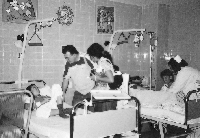
Cuba
is noted for its excellent primary care system, which emphasizes prevention
at the local level. Patients who need more specialized treatment seek
care at regional polyclinics and facilities like the National Institute
for Oncology (above).

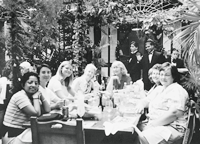
A small group of Emory nursing students and faculty made history as the first participants in a course in Cuba designed for nurses by the School of Nursing and MEDICC.
A Primary
Experience
Students, faculty study Cuban health system
What better way to
begin the new year than by making history and getting credit for it at
the same time? A small group of Emory nursing undergraduates began 2002
as the first participants in a course in Cuba designed for nurses by the
School of Nursing and MEDICC (Medical Education Cooperation with Cuba),
whose office is in the nursing school building. MEDICC collaborates with
the National School of Public Health in Cuba to provide electives there
for health sciences students from the United States.
For the five Emory nursing students and four faculty members who made
the 12-day journey, preparing for the trip was excitement enough without
the rare snowstorm that hit Atlanta on the day they left in early January.
Once in Havana, they immersed themselves in a nation where “the people
live as in a poor country but die as in a rich country,” says MEDICC
director Diane Appelbaum, who led the group. “Cuba has the same leading
causes of death as in the United States—heart disease, cancer, and
stroke.”
But the students and faculty also found something very different from
the United States. Through a series of lectures and field trips to clinics,
hospitals, and health education institutes, they saw firsthand what their
pre-trip seminars and readings had taught them—that Cuba has developed
a successful primary care system that places a premium on health promotion
and prevention.
“Cuba’s health care system is very grassroots and is geared
toward education and prevention of diseases—each person has a nurse
and a doctor who lives in their community. I had read a lot about it,
and it seems to work well,” says D.J. Smith, an associate faculty
member in adult and elder health at Emory.
What Smith and the others witnessed was a thriving primary care system
comprised of thousands of consultorios—local clinics operated
by doctor-nurse teams who live on the premises and care for approximately
150 families in the community. Patients who need more specialized services,
such as x-rays or lab work, visit the polyclinic, which serves about 20
consultorios.
Because of its health system, Cuba provides a quality of care comparable
to, and in some instances, better than the United States. As of 2000,
life expectancy in Cuba was 76.3 years compared with 76.8 years in the
United States. For every 10,000 people, Cuba has 58.2 doctors—more
than double the number of US doctors—26.5—for the same number
of people.
“We chose to study Cuba’s health care system because the people
there have elevated the health of the population from levels similar to
other countries in the area, such as Haiti and the Dominican Republic,”
says nursing student Nicole Smith, 02N. “Forty years ago, Cuban statistics
were in line with neighboring countries in the Caribbean and Central America.
Cuba’s system is special because it has helped the people achieve
this level of health. What’s more amazing is that it accomplished
this in only 40 years.”
In preparation, students and faculty read up on Cuba’s history, including
how the country rebuilt its health care system following Communist President
Fidel Castro’s rise to power in 1959 and how US economic sanctions
against Cuba and the collapse of the Soviet Union have forced the country
to make do with little, including medical supplies.
“I went to Cuba with a certain amount of skepticism about how well
the health care system works because the resources there are so limited,”
admits Menaka Ponnambalam, 03N. “There’s a lot of emphasis on
caring for mothers and children, and the doctors and nurses work closely
with the families. The efficiency lies in the spirit of maintenance of
the health care system. Everyone feels ownership in the system because
they are part of the whole.”
Among other practices that Emory students and faculty in Cuba observed
was the use of alternative medicine. Though it is a fairly recent addition
to the medical and nursing school curricula in Cuba, health providers
there regard it as an important part of treatment and prevention.
The next time Ponnambalam has a sinus headache, she may wish herself back
to Havana, where Cuban physician Dr. Fe Bosch vanquished her pain by applying
acupressure to points in her hands and head.
“I could literally feel my sinuses start to drain,” the student
remembers. “The doctor was head of the pain clinic and head of anesthesiology,
and she was 70 years old. She was absolutely amazing.”
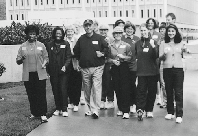
A
Walk on the Rainy Side
Wet weather doesn’t dampen enthusiasm
for exercise
Hospital
nurses do it every day. Madge Donnellan (third from right in photo), a
clinical associate professor of nursing specializing in health education,
figures they walk 10,000 steps or more each day. That’s a good thing
when it comes to staying fit through exercise.
To make that point, faculty and staff in the School of Nursing put on
the proper footwear this spring to walk with Michael Johns (third from
left), director of the Woodruff Health Sciences Center (WHSC). Last fall,
in a speech looking back at his first five years at Emory, Johns outlined
a new set of goals and priorities for “Making People Healthy.”
In keeping with that spirit, he sent pedometers to all WHSC employees,
along with a charge to make themselves healthy by walking 10,000 steps
a day. Of course, that includes faculty and staff in the nursing school.
In preparation for their walk with Johns, Donnellan gave everyone pointers
on what type of shoes to wear and tips for setting their pedometers. Although
showers forced the walkers indoors for part of the afternoon, the wet
weather did not diminish their good intentions to eat right, sleep right,
and take 10,000 steps a day.